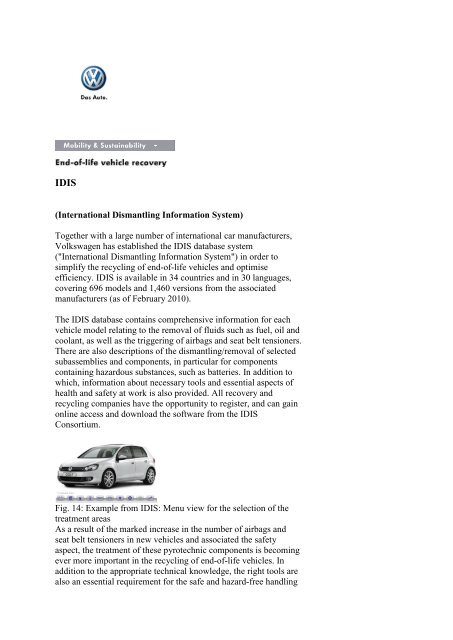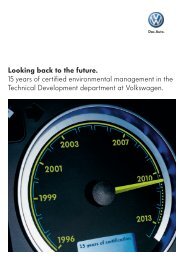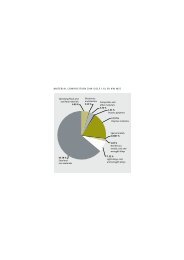(International Dismantling Information System ... - Volkswagen AG
(International Dismantling Information System ... - Volkswagen AG
(International Dismantling Information System ... - Volkswagen AG
You also want an ePaper? Increase the reach of your titles
YUMPU automatically turns print PDFs into web optimized ePapers that Google loves.
IDIS<br />
(<strong>International</strong> <strong>Dismantling</strong> <strong>Information</strong> <strong>System</strong>)<br />
Together with a large number of international car manufacturers,<br />
<strong>Volkswagen</strong> has established the IDIS database system<br />
("<strong>International</strong> <strong>Dismantling</strong> <strong>Information</strong> <strong>System</strong>") in order to<br />
simplify the recycling of end-of-life vehicles and optimise<br />
efficiency. IDIS is available in 34 countries and in 30 languages,<br />
covering 696 models and 1,460 versions from the associated<br />
manufacturers (as of February 2010).<br />
The IDIS database contains comprehensive information for each<br />
vehicle model relating to the removal of fluids such as fuel, oil and<br />
coolant, as well as the triggering of airbags and seat belt tensioners.<br />
There are also descriptions of the dismantling/removal of selected<br />
subassemblies and components, in particular for components<br />
containing hazardous substances, such as batteries. In addition to<br />
which, information about necessary tools and essential aspects of<br />
health and safety at work is also provided. All recovery and<br />
recycling companies have the opportunity to register, and can gain<br />
online access and download the software from the IDIS<br />
Consortium.<br />
Fig. 14: Example from IDIS: Menu view for the selection of the<br />
treatment areas<br />
As a result of the marked increase in the number of airbags and<br />
seat belt tensioners in new vehicles and associated the safety<br />
aspect, the treatment of these pyrotechnic components is becoming<br />
ever more important in the recycling of end-of-life vehicles. In<br />
addition to the appropriate technical knowledge, the right tools are<br />
also an essential requirement for the safe and hazard-free handling
of pyrotechnic components. For that reason the car industry has<br />
developed a standard ignition unit for pyrotechnic components.<br />
With this ignition unit, all electronic pyrotechnic components can<br />
be safely and reliably triggered in the course of recovery, thus<br />
excluding the possibility of uncontrolled ignitions.<br />
Fig. 15: Airbag system in the Polo V<br />
End-of-life vehicle recovery<br />
The recovery of end-of-life vehicles is carried out in three stages:<br />
<strong>Dismantling</strong>, shredding and the treatment of shredder residues, e.g.<br />
by means of the VW SiCon process.<br />
Stage 1: <strong>Dismantling</strong><br />
The recovery process starts with the handover of the end-of-life<br />
vehicle at a certified dismantler's facility. There the vehicle details<br />
are recorded, the certificate of destruction is issued for the vehicle's<br />
last owner, the battery is removed and all pyrotechnic components<br />
such as airbags, seat belt tensioners, battery safety terminal are<br />
triggered and thus made harmless. Then all the fluids (petrol,<br />
engine, gearbox and shock absorber oil, brake fluid, coolant, air<br />
conditioning system fluid) are drained off or sucked out. These are<br />
collected in separate containers and stored securely until<br />
subsequent recycling.<br />
Fig. 16: Removal of fuel, lubricants and other fluids using modern<br />
technology (photo: MAS Fahrzeugrecycling GmbH, Etzin)<br />
The dismantling process includes numerous components and<br />
subassemblies that are directly sold as used spares by the vehicle<br />
dismantler. Tyres and catalytic converters, glass and plastic parts<br />
are also removed. The removal of plastic parts for materials<br />
recycling is dependent on the basic economic conditions and the<br />
demand for recycled materials on the market.<br />
Seite 2
Fig. 17: Used spares / starter motors (photo: MAS<br />
Fahrzeugrecycling GmbH, Etzin)<br />
Stage 2: Shredder<br />
On conclusion of the dismantling work the remaining body is<br />
crushed so that it can be transported in a compact and costeffective<br />
form to the shredder facility. Shredding is a process that<br />
has been established for more than 50 years – shredders were<br />
developed for the recycling of metallic materials, particularly<br />
ferrous materials. In the shredder the crushed body is broken up<br />
with the aid of rotating hammers into pieces no bigger than a fist<br />
within a few seconds. These are then fed into to a subsequent<br />
multi-stage sorting process.<br />
The first stage of separation is airstream sorting (vacuum<br />
extraction). This is a mechanical process in which the light<br />
shredded parts are separated from the heavy ones in an artificially<br />
generated airstream. The light parts form the shredder light fraction<br />
(SLF) and are primarily comprised of light plastics, but they also<br />
include glass, wood, paint particles and textiles.<br />
The heavy fractions are then taken to the magnetic separator, which<br />
extracts a fraction of ferrous and steel materials from the mass<br />
throughput on the basis of their strong magnetic properties. This<br />
fraction is used as a raw material in the steel industry without any<br />
further treatment.<br />
The remaining heavy components, which are also called the<br />
shredder heavy fraction (SHF), are made up of a mixture of nonferrous<br />
(NF) metals (aluminum, copper, zinc,…) and<br />
predominantly organic materials (rubber and other heavy plastics).<br />
The SHF is the most valuable shredder fraction because of the high<br />
proportion of non-ferrous metals.<br />
In order to recover the NF metals in subsequent process stages, the<br />
shredder heavy fraction is further processed at the shredder facility<br />
itself or at other plants. Common techniques used for this purpose<br />
include the eddy current separator and sink-float systems. Sensorbased<br />
sorting systems are now being used to an increasing extent.<br />
The non-metallic materials remaining after the shredder heavy<br />
fraction has been processed are designated along with the shredder<br />
light fraction as shredder residues, which were in the past sent<br />
Seite 3
unused to landfill as a result of their non-homogeneous<br />
composition. However, new advances in treatment technology such<br />
as the VW-SiCon process now make it possible to separate<br />
shredder residues into various fractions and to use them as a new<br />
source of raw materials.<br />
Stage 3: VW-SiCon process<br />
The VW-SiCon process is an innovative mechanical treatment<br />
process for shredder residues, which was developed in the context<br />
of a cooperative venture between <strong>Volkswagen</strong> <strong>AG</strong> and SiCon<br />
GmbH. It is comprised of several treatment steps, which have been<br />
recombined and optimised. This combination makes it possible to<br />
make further use of the majority of the otherwise unused shredder<br />
residues.<br />
In the VW-SiCon process the shredder residues are first of all<br />
further broken up, in order then to separate out a raw sand fraction<br />
and a raw fibre fraction from the raw granulate fraction by means<br />
of screening and airstream sorting.<br />
Fig. 18: The three main fractions of the VW-SiCon process<br />
These three raw fractions are refined in further processing stages<br />
by means of the selective removal of impurities and the adjustment<br />
of optimum physical parameters, and adapted to the requirements<br />
of the subsequent systems. The aim of the refinement stages is to<br />
create raw materials which are needed in industrial plants.<br />
The refined shredder granulate is a low-chlorine and low-metal<br />
fraction made up of hard plastics, which can be used for steel<br />
production. In the blast furnace it serves as a reducing agent for the<br />
iron ore, replacing heavy oil and hence reducing sulphur emissions.<br />
Shredder fibres come from textile fibres and foam seat cushions,<br />
and they represent an effective dewatering agent for sewage sludge.<br />
They can be used as a substitute for fine-ground, high-quality coal<br />
dust, which is otherwise used in the dewatering and recovery of<br />
sewage sludge.<br />
Shredder sand represents a mixture of glass, fine-grained iron, rust,<br />
thin copper cables, dust containing lead and zinc and paint<br />
residues, which is used for backfilling of mines. <strong>Volkswagen</strong> is<br />
involved in a research project with the aim of completing this<br />
materials cycle and recycling the residual metals contained in the<br />
shredder sand, and then using the metal-free sand as a building<br />
Seite 4
material.<br />
Fig. 19: The three-stage recovery process<br />
From end-of-life vehicle to raw-material source<br />
To illustrate the recovery process there is a computer animation<br />
available, which explains "The Principle" in graphic terms.<br />
From end-of-life vehicle to raw-material source – "The Principle"<br />
The practical implementation of the recovery process is shown by<br />
"The Practice", a film produced in various locations.<br />
From end-of-life vehicle to raw-material source – "The Practice"<br />
The innovative three-stage recovery process including VW-SiCon<br />
process enables 95 % of an end-of-life vehicle to be economically<br />
recovered. This process is also preferable from an environmental<br />
point of view to the extensive manual dismantling of end-of-life<br />
vehicles, as the process technology treats all the shredder residues<br />
and hence recovers virtually all the materials.<br />
A comparative ecobalance, produced according to DIN EN ISO<br />
14040, confirms the ecological advantages of the VW-SiCon<br />
process. As a result of these advantages over conventional<br />
processes, it has already been awarded three prestigious<br />
environmental prizes.<br />
Fig. 20: Environmental prizes for the VW-SiCon process<br />
© <strong>Volkswagen</strong> 2012<br />
Seite 5




